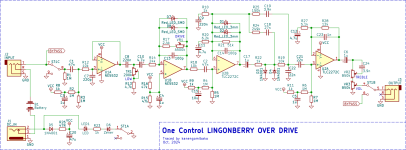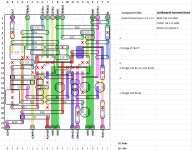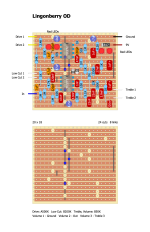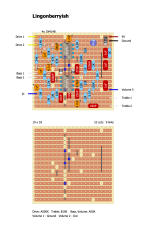Chuck D. Bones
Circuit Wizard
Another One Control / BJFe creation. Similar to the Strawberry Red OD (Snozzberry OD), it has a Bass Cut up front, followed by a variable gain stage driving a Honey Bee style OD stage and a Treble Boost at the end. Typical of BJ's designs, the EQ knobs are subtle. Here's Kanengomibako's trace of the Lingonberry OD. This thing is a MotherFucker in stock form, but you know I just can't leave well enough alone.

Like the Strawberry, it has separate Vrefs for each stage. Overkill IMO. C7 and the Vref for U2B (schematic above) are extraneous IMO because U1B's output is plenty close to Vref. I replaced the passive treble Boost at the last stage with an active Treble Boost/Cut. On the breadboard, I added a "HamishR switch" to select between red and IR LEDs for D3 & D4 (switch not shown in schematic below). IMO, red and IR sound so similar that one can install one or the other. The IR LEDs have a lower Vf, similar to two Si diodes in series. For most control settings, you'd be hard-pressed to hear the difference. D1 and D2 don't glow unless you dime DRIVE and slam this with a booster. Their purpose is to prevent U1B from hitting the rails. BASS has a much broader sweep in both directions with the new component values. I bumped R6 up a tad so that DRIVE is not so touchy near zero. Unlikely that anyone will set it below 2 (9:00). Other than that, I left the gain and OD stages alone. Except for adding the COMP pot. HamishR gave me that idea and it's a good one. With COMP dimed, D5 & D6 provide a ton of compression. As we turn COMP down, the dynamics and volume increase. The volume increase necessitates putting the LEVEL control ahead of the last stage to prevent it from saturating. VR3 now provides about 9dB boost or 11dB cut at 10KHz. Compare that with 6dB boost or 0dB cut with the original circuit. The original circuit uses TLC2272 for U2 because it has a rail-to-rail output for maximum headroom. I don't have any of those (yet), so I tried LT1490 (also rail-to-rail opamp), CA3240, CA3260 & TL072. They sound pretty similar, so in a pinch, I'd use the good 'ol TL072. At the moment U2 is LT1490. U1 is not critical, as long as it's low-noise, so TL072 is good there as well.
I may fiddle a few component values, but it's pretty damn good as drawn. R13, R14, C10 & C11 affect the midrange tone. C6 affects the bottom-end. C15 & C16 control the TREBLE control's freq range.

U1 is at the lower right, U2 top center. Spare opamps bottom center. D3 & D4 light up quite nicely, especially if they are super-brights. One or both could be used to light up something like a satanic sheep on the front panel.
Knobs (L-R): LEVEL - TREBLE - COMP - (HamishR Switch) - BASS - DRIVE


Like the Strawberry, it has separate Vrefs for each stage. Overkill IMO. C7 and the Vref for U2B (schematic above) are extraneous IMO because U1B's output is plenty close to Vref. I replaced the passive treble Boost at the last stage with an active Treble Boost/Cut. On the breadboard, I added a "HamishR switch" to select between red and IR LEDs for D3 & D4 (switch not shown in schematic below). IMO, red and IR sound so similar that one can install one or the other. The IR LEDs have a lower Vf, similar to two Si diodes in series. For most control settings, you'd be hard-pressed to hear the difference. D1 and D2 don't glow unless you dime DRIVE and slam this with a booster. Their purpose is to prevent U1B from hitting the rails. BASS has a much broader sweep in both directions with the new component values. I bumped R6 up a tad so that DRIVE is not so touchy near zero. Unlikely that anyone will set it below 2 (9:00). Other than that, I left the gain and OD stages alone. Except for adding the COMP pot. HamishR gave me that idea and it's a good one. With COMP dimed, D5 & D6 provide a ton of compression. As we turn COMP down, the dynamics and volume increase. The volume increase necessitates putting the LEVEL control ahead of the last stage to prevent it from saturating. VR3 now provides about 9dB boost or 11dB cut at 10KHz. Compare that with 6dB boost or 0dB cut with the original circuit. The original circuit uses TLC2272 for U2 because it has a rail-to-rail output for maximum headroom. I don't have any of those (yet), so I tried LT1490 (also rail-to-rail opamp), CA3240, CA3260 & TL072. They sound pretty similar, so in a pinch, I'd use the good 'ol TL072. At the moment U2 is LT1490. U1 is not critical, as long as it's low-noise, so TL072 is good there as well.
I may fiddle a few component values, but it's pretty damn good as drawn. R13, R14, C10 & C11 affect the midrange tone. C6 affects the bottom-end. C15 & C16 control the TREBLE control's freq range.

U1 is at the lower right, U2 top center. Spare opamps bottom center. D3 & D4 light up quite nicely, especially if they are super-brights. One or both could be used to light up something like a satanic sheep on the front panel.
Knobs (L-R): LEVEL - TREBLE - COMP - (HamishR Switch) - BASS - DRIVE

Last edited:





